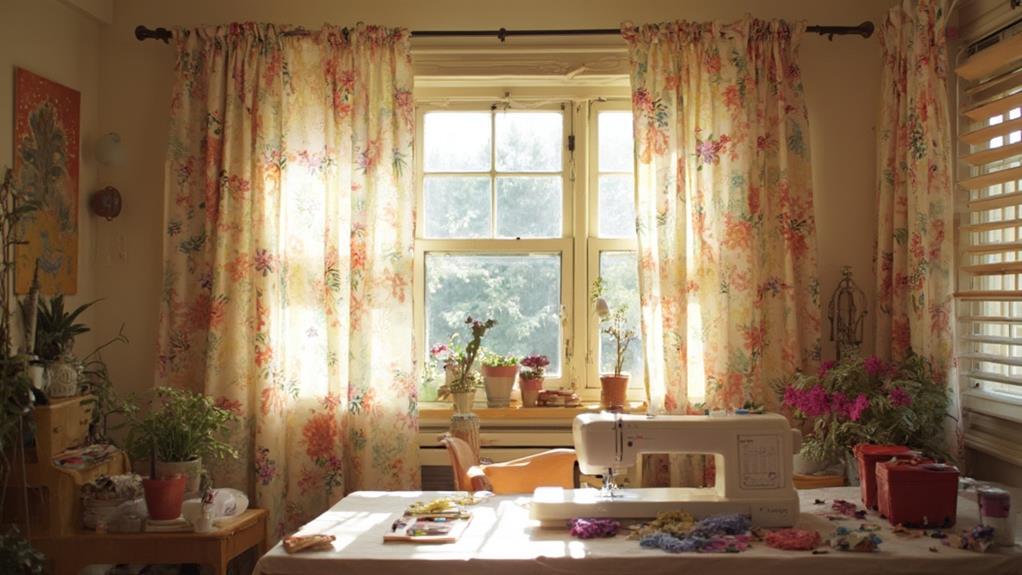Window treatments don't have to be expensive to be stylish and functional. DIY curtains and blinds offer budget-friendly solutions for any home. No-sew options like using hem tape or fabric glue can create professional-looking curtains without stitching. Repurposing materials such as sheets, tablecloths, or even vinyl records can yield unique window coverings. Store-bought curtains can be customized with trims or paint for a personalized touch. Natural materials like bamboo or jute provide affordable, eco-friendly options. Simple projects like tie-up shades or painted Roman shades allow for creativity on a budget. With a little ingenuity, you can transform your windows without emptying your wallet.
No-Sew Curtain Ideas
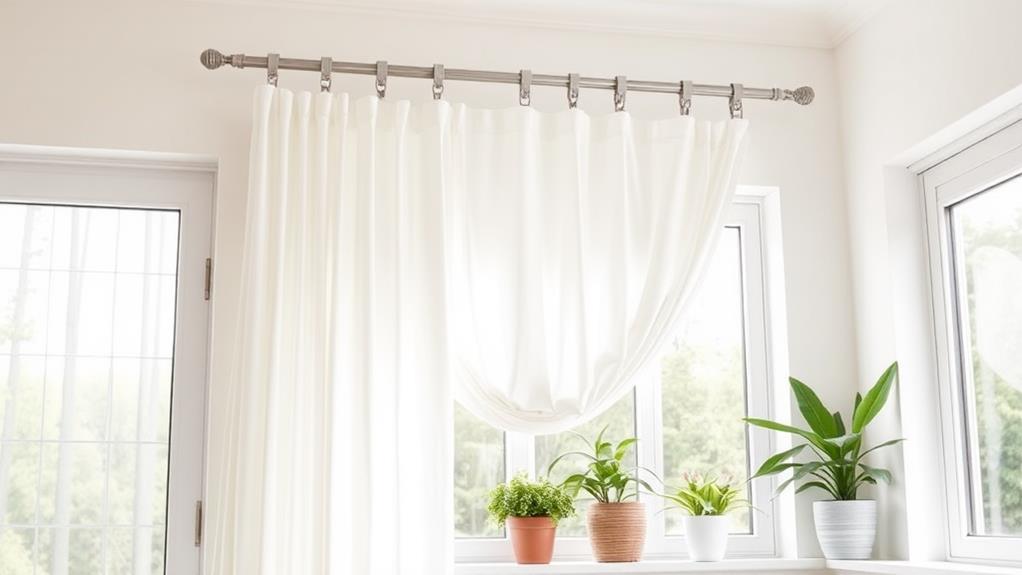
For those who shy away from needle and thread, no-sew curtain ideas offer an accessible entry point into DIY window treatments. These innovative solutions allow homeowners to create custom window coverings without the need for complex sewing skills or expensive equipment.
One popular no-sew option is the use of iron-on hem tape, which creates clean edges and secure seams with just the application of heat. Another method involves fabric glue, ideal for attaching trims, embellishments, or creating simple hems. For a rustic look, consider using curtain clip rings to hang fabric directly from a rod, eliminating the need for a sewn header.
Repurposing everyday items can also yield creative results. Tablecloths, bed sheets, or even attractive tea towels can be transformed into unique curtains with minimal effort. For a bohemian touch, try knotting strips of fabric together to form a textured curtain panel. Additionally, tension rods and adhesive Velcro strips offer simple hanging solutions that don't require permanent fixtures.
These no-sew techniques not only save time and effort but also allow for easy customization and updates to match changing decor preferences or seasons.
Repurposed Materials for Blinds
Frequently overlooked, everyday items can be ingeniously repurposed to create unique and cost-effective window blinds. Simple materials like bamboo, burlap, or even old maps can be transformed into functional and stylish window coverings.
Wooden slats from discarded pallets, when cleaned and sanded, make excellent Venetian-style blinds. Old vinyl records, carefully hung, create a distinctive and conversation-starting window treatment.
For a rustic look, consider using fabric remnants or vintage tea towels attached to a rod with clip rings. Wine corks, strung together, form an eco-friendly and visually interesting blind.
Repurposed mini blinds can serve as a base for various materials like fabric, paper, or even thin wood veneers. Old jewelry or beads can be strung to create a shimmering, light-filtering curtain.
When selecting repurposed materials, consider their durability, ease of cleaning, and light-filtering properties. Ensure that any chosen material can withstand exposure to sunlight without fading or deteriorating. With creativity and resourcefulness, these DIY blinds not only save money but also add a personal touch to your home decor while reducing waste.
Upcycled Sheet Curtains
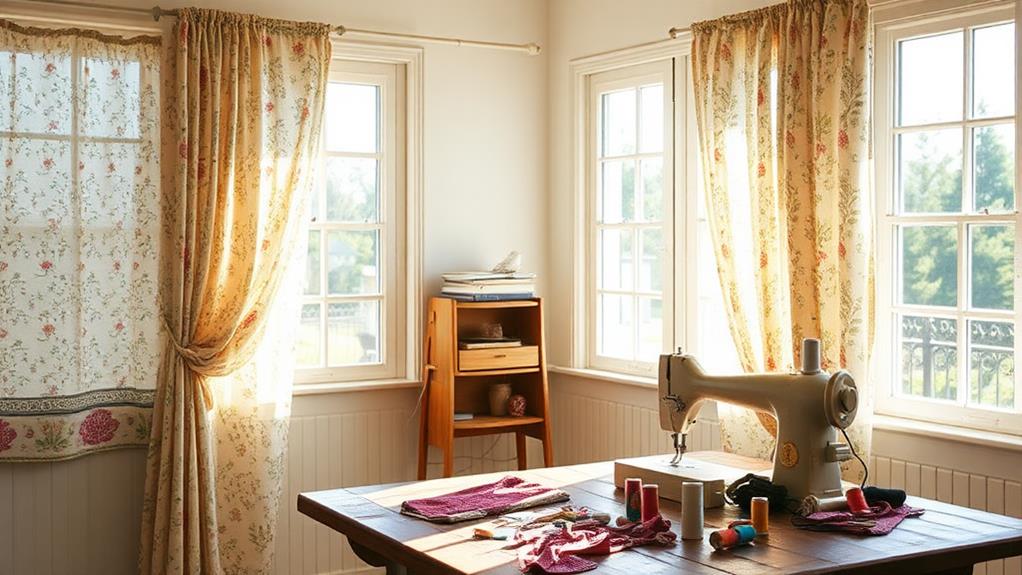
Bedsheets, often relegated to the linen closet, can be transformed into stylish and affordable curtains. This upcycling project offers a budget-friendly alternative to store-bought window treatments while giving new life to old or unused sheets.
To create sheet curtains, select flat sheets in colors or patterns that complement your room's decor. Measure your windows and add extra length for hemming and rod pockets.
Begin by washing and ironing the sheets to ensure a crisp appearance. Trim the sheets to size, leaving room for seam allowances. Fold and press the top edge to create a rod pocket, then sew it in place. For a more polished look, add a decorative header above the rod pocket. Hem the sides and bottom of the curtain panels for a clean finish.
Consider embellishing your sheet curtains with trims, tassels, or appliqués to enhance their visual appeal. For added insulation and light-blocking properties, line the curtains with a separate fabric layer. This DIY project not only saves money but also allows for customization to perfectly suit your space and style preferences.
Paint Your Own Roman Shades
Roman shades offer a sleek window treatment option that combines the functionality of blinds with the elegance of fabric curtains. For a budget-friendly approach, consider painting your own Roman shades. This DIY project allows for customization while saving money on expensive pre-made options.
To begin, select a light-colored, durable fabric such as cotton duck or linen. Measure your window and cut the fabric to size, adding extra length for folding. Create evenly spaced horizontal pockets for dowels, which will help the shade maintain its shape when raised.
Use fabric paint or acrylic paint mixed with a fabric medium to design your pattern. Geometric shapes, stripes, or botanical motifs work well for this application. Apply the paint using stencils, stamps, or freehand techniques. Allow the paint to dry completely before assembling the shade.
Attach a mounting board at the top and install a cord system for raising and lowering the shade. Finally, hang your custom-painted Roman shade and enjoy the unique, personalized window treatment that reflects your style while staying within your budget.
Customizing Store-Bought Curtains
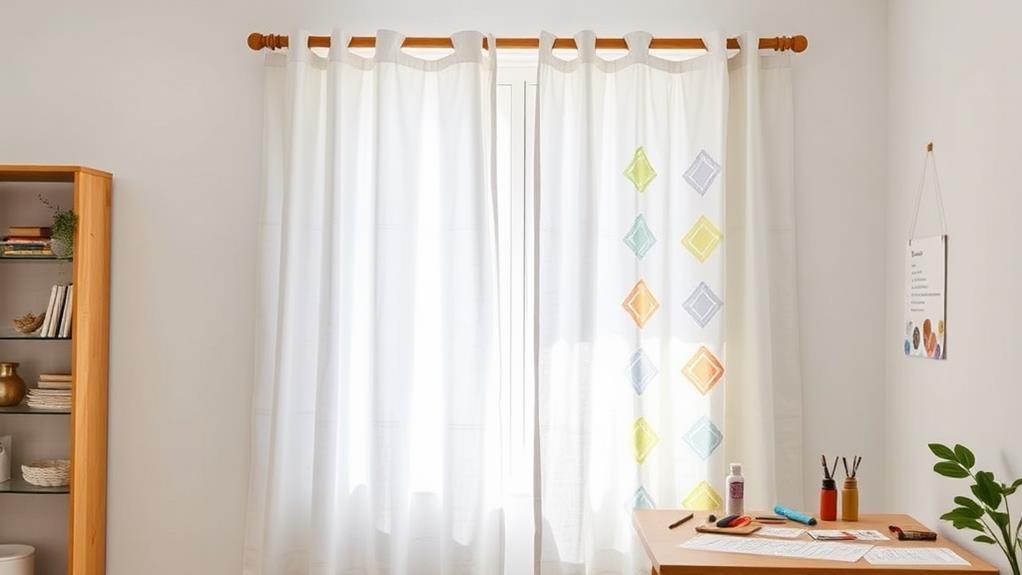
Store-bought curtains offer a convenient starting point for creating personalized window treatments. With a few simple modifications, you can transform standard curtains into unique, custom pieces that match your decor and style preferences.
One popular customization method is adding decorative trim or embellishments. Attach ribbons, pom-poms, or tassels along the edges or bottom hem to introduce color and texture. For a more substantial change, consider sewing a contrasting fabric border to the curtain panels, instantly elevating their appearance.
Another approach is to use fabric paint or stencils to create patterns or designs on plain curtains. This technique allows for endless possibilities, from geometric shapes to floral motifs. Alternatively, iron-on appliqués offer a no-sew option for adding visual interest.
For a functional upgrade, consider adding blackout lining to store-bought curtains. This enhances light-blocking capabilities and improves insulation. You can also adjust the length of curtains by hemming them or using no-sew hemming tape for a quick fix.
Lastly, updating curtain hardware can significantly impact the overall look. Replace basic curtain rods with more stylish options, or add decorative finials to existing rods for an instant aesthetic boost.
Natural Materials for Window Coverings
Embracing natural materials for window coverings offers an eco-friendly and aesthetically pleasing alternative to synthetic options. These sustainable choices not only reduce environmental impact but also add warmth and texture to your living spaces. Popular natural materials for window treatments include bamboo, jute, linen, and cotton.
Bamboo shades provide excellent light filtering properties while creating a tropical ambiance. They are durable, affordable, and can be easily customized to fit various window sizes.
Jute Roman shades offer a rustic charm and are ideal for casual or bohemian-inspired interiors. Linen curtains are prized for their lightweight, breathable nature and elegant drape. They work well in both formal and informal settings, offering a timeless appeal.
Cotton is versatile and easy to maintain, making it perfect for high-traffic areas or households with children and pets.
When selecting natural materials, consider factors such as light control, insulation, and maintenance requirements. Many of these materials can be enhanced with linings for improved functionality. By choosing natural window coverings, you can create a healthier home environment while adding a touch of organic beauty to your decor.
Quick and Easy Tie-Up Shades
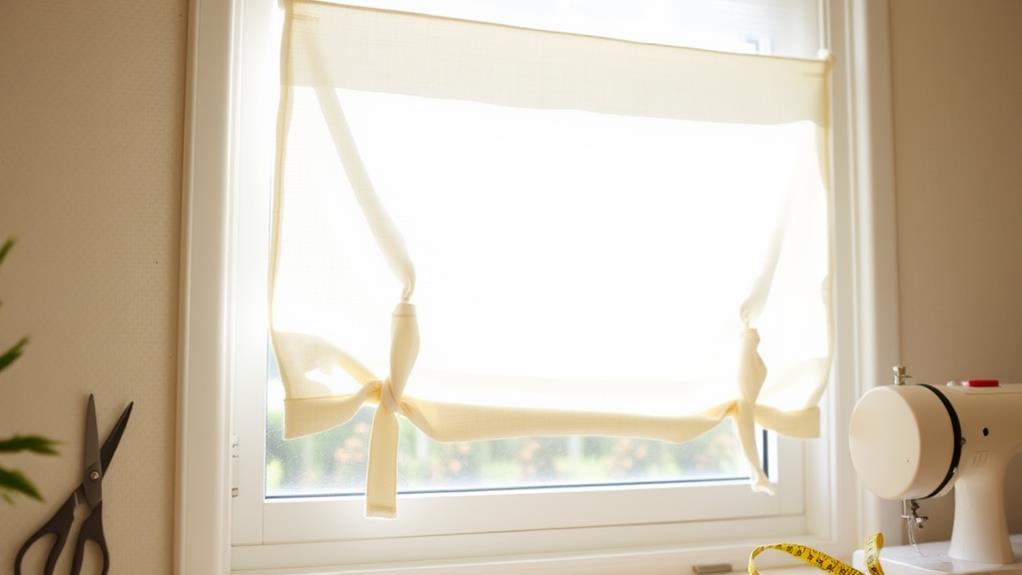
For those seeking a simple yet charming window treatment solution, quick and easy tie-up shades offer an excellent DIY option. These versatile window coverings can be crafted from various fabrics, allowing you to match your decor or add a pop of color to your space. The beauty of tie-up shades lies in their simplicity and functionality.
To create tie-up shades, start with a rectangular piece of fabric slightly wider than your window and about 1.5 times the desired length. Hem the edges and create a rod pocket at the top. Install a curtain rod above your window and hang the shade. Attach ties or ribbons at regular intervals along the bottom edge of the fabric.
When raised, the shade can be adjusted to different heights by tying the ribbons around the fabric at various points. This allows for easy light control and privacy management. Tie-up shades work well in casual spaces like kitchens, bathrooms, or children's rooms. They're also ideal for renters, as they can be easily removed without damaging walls. With minimal sewing skills required, these shades provide a cost-effective and customizable window treatment solution.
Affordable Hardware Solutions
While custom window treatments can be costly, there are numerous affordable hardware solutions available for DIY curtains and blinds. Budget-friendly options include tension rods, which are ideal for lightweight curtains and require no drilling. These adjustable rods fit snugly inside window frames and can be found at most home improvement stores for under $10.
For heavier curtains, consider using basic curtain rods with decorative finials. These come in various finishes and styles, typically ranging from $15 to $30. Wall-mounted brackets and supports are essential for secure installation and can be purchased separately or as part of a rod kit.
Another cost-effective option is to repurpose materials. Wooden dowels or PVC pipes can serve as curtain rods when paired with inexpensive metal brackets. Industrial pipe fittings offer a modern, industrial look and can be customized to fit any window size.
For blinds, consider using cord-free, spring-loaded roller shades. These are easy to install and operate, with prices starting around $20. Alternatively, bamboo or matchstick blinds provide a natural, textured look at a fraction of the cost of custom window treatments.
Creative Valance Alternatives
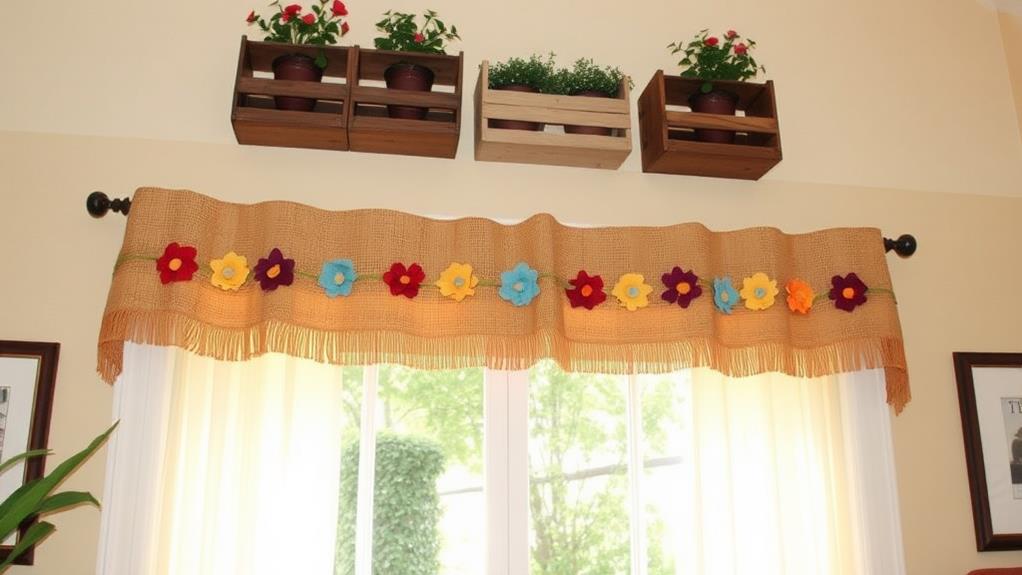
Creative valance alternatives can add a unique touch to your window treatments without the need for traditional fabric toppers. Consider repurposing everyday items for a fresh look. Wooden planks, painted or distressed, can be mounted above windows for a rustic charm. Vintage shutters, hung horizontally, offer a shabby chic aesthetic. For a modern twist, mount sleek metal sheets or repurposed corrugated tin.
Natural elements like driftwood, bamboo poles, or even intertwined branches can create an organic, textured valance. Book lovers might appreciate a shelf lined with colorful book spines above the window. Salvaged architectural elements such as old door pediments or ornate moldings can add character.
For a playful approach, string oversized wooden beads or colorful glass baubles on a sturdy rod. Woven basket bottoms, aligned in a row, provide texture and visual interest. Industrial-inspired options include using pipes, gears, or even bicycle wheels as unconventional valances. Wine enthusiasts might enjoy a row of empty bottles lined up on a narrow shelf. These creative alternatives not only serve as unique valances but also as conversation starters, adding personality to your space.
Frequently Asked Questions
How Do I Measure Windows Correctly for Curtains and Blinds?
To measure windows correctly for curtains and blinds, start by measuring the width at three points: top, middle, and bottom. For length, measure from the top of the rod or mounting position to your desired endpoint.
What's the Best Way to Clean Different Types of Window Treatments?
Different window treatments require specific cleaning methods. Vacuum or dust blinds regularly. Use a damp cloth for vinyl or aluminum. Dry clean fabric curtains or follow care labels. Steam clean heavy drapes. Spot clean as needed between thorough cleanings.
Can I Use Tension Rods for All Types of Curtains?
Tension rods are suitable for many lightweight curtains, particularly in smaller windows or temporary installations. However, they may not support heavier fabrics or larger window treatments effectively. Consider the curtain weight and window size when deciding on rod type.
How Do I Childproof My Window Treatments for Safety?
Like a vigilant guardian, childproofing your window treatments is crucial. Install cordless blinds or curtains, secure loose cords with cord cleats, and use breakaway devices. Keep furniture away from windows to prevent climbing accidents. Regularly inspect for potential hazards.
What Are the Energy-Saving Benefits of Different Window Covering Materials?
Different window covering materials offer various energy-saving benefits. Insulating fabrics reduce heat transfer, cellular shades trap air for improved thermal performance, and reflective materials deflect sunlight. Proper installation and usage can significantly impact a home's energy efficiency and comfort levels.
Conclusion
Window treatments need not be expensive to be effective and stylish. DIY options ranging from no-sew curtains to upcycled materials offer budget-friendly solutions for any home. Interestingly, a study by the U.S. Department of Energy found that medium-colored draperies with white-plastic backings can reduce heat gains by up to 33% when drawn over windows. By implementing these creative and cost-effective ideas, homeowners can achieve both aesthetic appeal and improved energy efficiency without breaking the bank.
